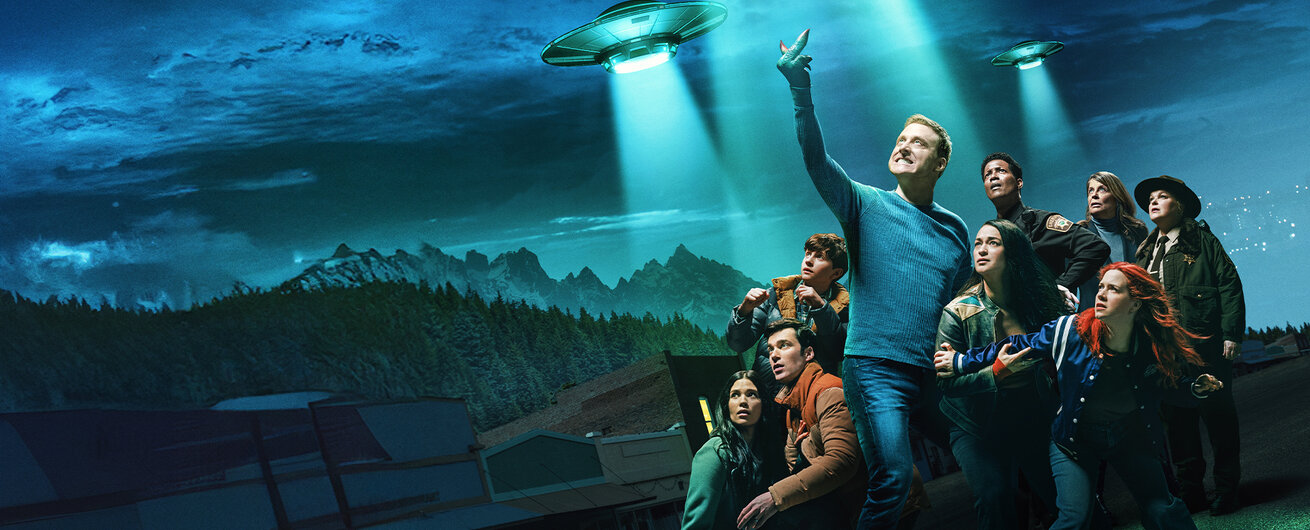Create a free profile to get unlimited access to exclusive videos, sweepstakes, and more!
Did Scientists Find Evidence of Alien Megastructures in the Milky Way?
Maybe, but we need to take a closer look.
In SYFY's Resident Alien, an extraterrestrial who goes by the name of Harry Vanderspiegle (Alan Tudyk) arrives on Earth, the lone emissary of an advanced alien species. While we’ve merely scratched the surface of our technological capability, they’ve cracked faster-than-light space travel.
One of our biggest limitations is our inability to efficiently gather and use enough energy. Transitioning from a society which is bound to a planet into one which is interplanetary or interstellar undoubtedly requires a whole lot of juice. It’s been suggested that the development of a technological civilization could be measured by the proportion of energy it gathers from its parent star.
Advanced alien societies might capture much more from their star, or any star they encounter for that matter, by building a vast megastructure surrounding it. Imagine a cloud of orbital solar panels soaking up starlight and transforming it into electricity and you’re most of the way there. Freeman Dyson first suggested the notion in 1960 and these hypothetical alien megastructures have borne his name ever since.
For More on Extraterrestrials:
A Timeline of the Alien Franchise's Xenomorph in All Its Terrifying Forms
How Scientists Are Attempting to Communicate with Aliens: The Science Behind Arrival
NASA Measures Enough Oxygen for 1 Million Humans on Europa, But Perhaps Not Enough for Aliens
Dyson Spheres and Other Alien Megastructures
Alien engineers could build their energy-gathering structures in several ways. On the low end of the spectrum you have what we’re currently doing, relatively inefficient solar energy capture with nascent solar cells. Our best solar panels only capture a small fraction of the sunlight that hits them, and we don’t have very many of them. With a few exceptions for spacecraft, we’re only collecting sunlight that hits our planet and even then, not very much of it. At the other extreme, you have a Dyson Sphere, a hypothetical structure which totally encapsulates a star, capturing all of its energy output.
At about a 7 or 8 on the scale you have the less complex but still highly effective Dyson Rings and Dyson Swarms. These might capture the energy of 20% or 30% of a star, without totally obscuring it. If anyone out there has managed to build a starlight-scarfing megastructure, we might be able to see them, providing a potential target for alien-hunting astronomers.
No solar cell or energy capturing device of any kind can ever be 100% efficient. Some of the starlight hitting the structure will be captured not as energy but as heat. Even if the star were totally covered by a Dyson Sphere, we would still be able to see it from the infrared radiation it gives off. A star surrounded by a swarm or set of rings might exhibit bizarre period dimming events alongside an unusual infrared signature. In short, if there are megastructures out there, we should be able to find them.
Astronomers Find 7 Candidate Stars, Potentially Housing Alien Megastructures
In a recent study published in the Monthly Notices of the Royal Astronomical Society, astronomers looked for infrared excess emissions (IEEs) among the 5 million or so Milky Way stars surveyed by the Two Micron All-Sky Survey (2MASS), NASA’s Wide-Field Infrared Survey Explorer (WISE), and the ESA’s Gaia mission.
For each IEE they found, astronomers attempted to explain them away through known means. A star surrounded by a cloud or disk of debris, like the rubble leftover after planets smash together during the early days of a stellar system for instance, might give off similar signals. Once they’d explained away everything they could, scientists were left with seven candidates, all red dwarf stars within 1,000 light-years from here.
Of course, there are almost certainly more mundane explanations for the excess infrared signatures of these seven stars, but they give us a starting point in the hunt for alien technology and the extraterrestrials who built it. Next steps will involve investigating those stars with more powerful instruments, like those aboard the JWST, and looking for other biosignatures like atmospheric carbon, oxygen, and molecules which are only known to be produced by life. If Harry and his buddies are out there, we’re doing everything we can to find them.
In the meantime, catch up with Resident Alien, streaming now on Peacock.



































